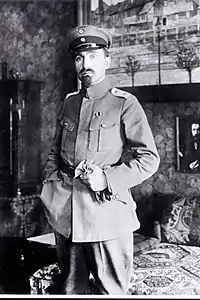Hermann Struck
Hermann Struck (6 March 1876 – 11 January 1944) was a German Jewish artist known for his etchings.[1]

Biography

Hermann Struck (Chaim Aaron ben David) was born in Berlin. He studied at the Berlin Academy of Fine Arts. In 1904, he joined the modern art movement known as the Berlin Secession.[1] In 1900, Struck met Jozef Israëls, a Dutch artist, who became his mentor. Both were recognized as leading artists of their time.[2]
In 1908, Struck published "Die Kunst des Radierens" ("The Art of Etching"), which became a seminal work on the subject.[2] It was a textbook that offered both theory and practical instruction.[3] Struck's students included Marc Chagall, Lovis Corinth, Jacob Steinhardt, Lesser Ury and Max Liebermann.[2]
In 1899, upon completing his studies at the Berlin Academy, he was banned from teaching there because he was Jewish. He signed his work with his Hebrew name, Chaim Aaron ben David, and a Star of David.[2] Struck did commission portraits of Ibsen, Nietzsche, Freud, Albert Einstein, Herzl, Oscar Wilde and other leading figures of the time.[2]

Struck was a fervent Zionist and Jewish activist. He visited the Land of Israel in 1903, displayed his art at the Fifth Zionist Congress, and was a founder of the Mizrachi Religious Zionist movement. At the same time, he was a German patriot and volunteered for military service in World War I[2] serving as a translator, liaison officer and military artist.[2] He was awarded the Iron Cross 1st Class and promoted to an officer for bravery, in 1917 he became the referent for Jewish affairs at the German Eastern Front High Command[4]
Struck immigrated to Palestine in 1922, taught at Bezalel Academy and helped establish the Tel Aviv Museum of Art.[2] He visited Berlin every summer until the Nazis rose to power.[2]
He died in Haifa, Palestine, 1944.
Collections
Other institutions
Besides the Hermann Struck Museum, Struck's work is held in the collections of several other institutions worldwide. These include the Brooklyn Museum,[7] the Jewish Museum (Manhattan),[8] the Haifa Museum of Art,[9] the Leo Baeck Institute, New York,[10] the University of Michigan Museum of Art,[11] the British Museum,[12] the Museum of New Zealand Te Papa Tongarewa,[13] and the Fine Arts Museums of San Francisco.[14]
Selected works
.jpg.webp)
 Portrait of Theodor Herzl
Portrait of Theodor Herzl Lithograph of a rabbi. In the collection of the Jewish Museum of Switzerland.
Lithograph of a rabbi. In the collection of the Jewish Museum of Switzerland. Woodcut by Hermann Struck which reads "The land of Israel" in Hebrew. In the Leo Baeck Institute's collection.
Woodcut by Hermann Struck which reads "The land of Israel" in Hebrew. In the Leo Baeck Institute's collection.
See also
References
- "Exhibitions". Archived from the original on 2008-04-22. Retrieved 2008-04-22.
- "Here and There" Smadar Sheffi, Haaretz Guide, March 7, 2008, review of Herman Struck retrospective: Master Print Maker,Open Museum, Tefen Industrial Park, Israel
- Hecht Museum: Hermann Struck
- The art and artists of the fifth Zionist Congress, 1901: heralds of a new age. Gilya Gerda Schmidt. 2003. ISBN 9780815630302. Retrieved 2009-08-25.
- Kamin, Debra (3 October 2013). "Home of Haifa artist Hermann Struck is reborn as museum". Times of Israel. Retrieved 9 January 2019.
- Haifa Museum honors legacy of now forgotten Hermann Struck
- "Brooklyn Museum". www.brooklynmuseum.org. Retrieved 2021-05-11.
- "The Jewish Museum". www.thejewishmuseum.org. Retrieved 2021-05-11.
- "Hermann Struck, 1876-1944An Old Spanish Jew, 1919 Dry point1185-68 - Collection". Haifa Museums - Six Museums in One Frame. Retrieved 2021-05-11.
- "Hermann Struck". Leo Baeck Institute. Retrieved 2021-08-05.
- "Exchange: Snow". exchange.umma.umich.edu. Retrieved 2021-05-11.
- "print | British Museum". The British Museum. Retrieved 2021-05-11.
- "Loading... | Collections Online - Museum of New Zealand Te Papa Tongarewa". collections.tepapa.govt.nz. Retrieved 2021-05-11.
- "Alter Jude aus Jaffa - Hermann Struck". FAMSF Search the Collections. 2017-09-20. Retrieved 2021-05-11.
External links
- Figureworks.com/20th Century work Archived 2017-07-31 at the Wayback Machine
- Browse digitized art works by Hermann Struck at the Leo Baeck Institute, New York